NVIDIA Release ‘ULMB 2’ for Improved Motion Clarity, Including Updates for 2 Existing Monitors
Originally published 29 May 2023, last updated 15 Nov 2023
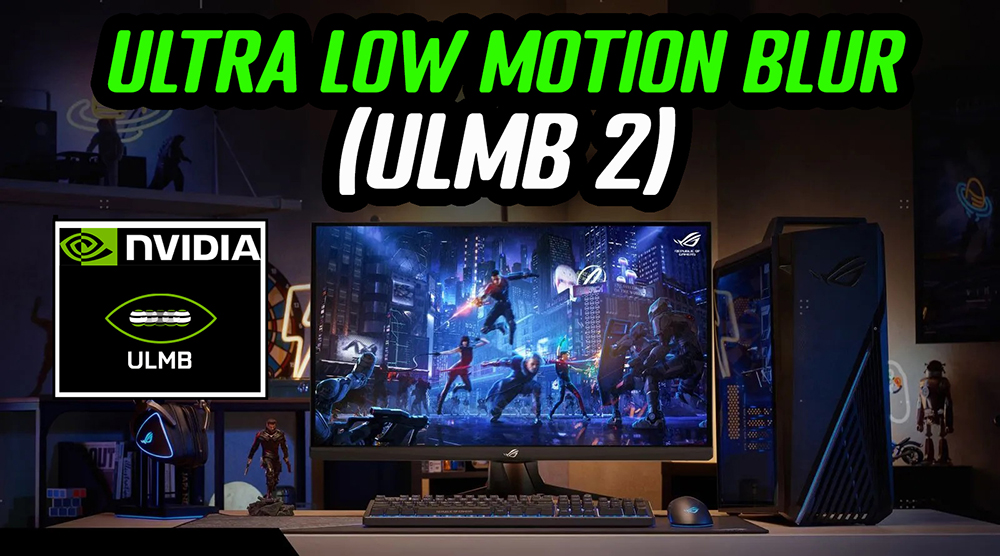
Introduction
NVIDIA are today announcing the launch of their ULMB 2 (Ultra Low Motion Blur 2) technology and its accompanying certification scheme. This is an update to their previous ULMB capability, bringing about improvements in motion clarity and gaming experience for monitors, as well as setting criteria for performance under a new certification scheme. Via a firmware update, two existing monitors on the market will even be able to benefit from an update to ULMB 2 now, with other displays planned for release later in the year that will feature the updated tech. We had chance to speak to NVIDIA about the new technology, updates and changes this week in detail. Read on for the full information.
What is ULMB?
As a quick introduction in case you are not familiar with this term, ULMB stands for “Ultra Low Motion Blur” and is NVIDIA’s strobing backlight, blur reduction mode. It’s a feature of their Native G-sync module, and is similar to competing blur reduction technologies implemented directly by monitor manufacturers on many gaming screens. We talked about the technology more broadly in our Motion Blur Reduction Backlight article, so if you’re unfamiliar we would encourage you to read that. Basically the backlight of the monitor is strobed off and on rapidly, usually in sync with the refresh rate of the screen, which helps reduce the perceived motion clarity for the user in fast moving motion content. Some gamers really like these technologies for enhancing clarity in games, although the implementation and performance of blur reduction modes really does vary quite a lot. Sometimes they are well implemented, other times they look really bad and end up being unusable.
What Makes a Good Blur Reduction Mode
For an effective blur reduction mode you really need:
- Fast and reliable response times without any overshoot artefacts and halos – the equivalent technology on OLED screens (called BFI, or “Black Frame Insertion”) works very well because of the near-instant response times of that panel technology. This helps keep the image clean and avoids ghosting images and trails.
- The ability to use the blur reduction mode at a range of supported refresh rates, especially the maximum refresh rate which you bought the screen for – this isn’t always the case, sometimes it’s capped at a lower refresh rate. The ability to use the blur reduction mode at the same time as VRR is an added bonus, but actually very hard to implement properly and with optimal performance. Trying to coordinate response times, overdrive, frame rate and strobing is not easy.
- The strobe timing to have been tuned by the manufacturer so that the clearest part of the image is in the central region of the screen where your view is likely to be focused – or even better, the ability for the user to adjust this timing themselves via the monitor menu or accompanying software tool.
- Minimal “strobe cross-talk” which is the ghosting and trailing of the image evident in blur reduction operation. It’s very difficult to eliminate this fully, but it should be reduced as much as possible. It’s tied to things like the response times and overshoot as well.
- A suitably high brightness range – because the backlight is being strobed off and on rapidly, you will normally lose a lot of brightness compared with off mode, in many cases being too dark for a lot of users. You need the screen to still be able to reach decent brightness levels in blur reduction mode.
- The ability to tweak the strobe length is an added bonus, although we don’t feel it offers a huge benefit to most people. Where available, this option allows you to make the ‘on’ part of the strobe shorter if you want, which can sometimes help fine tune motion clarity (the shorter the ‘on’ period the better in theory), but it does come at the cost of screen brightness. It might be a slightly better way to alter the screen brightness to your liking than simply using the brightness control, as you get a small amount of motion clarity benefit at the same time if you want to make the screen darker, but it’s usually very slight.
ULMB is Powered by the G-sync Module
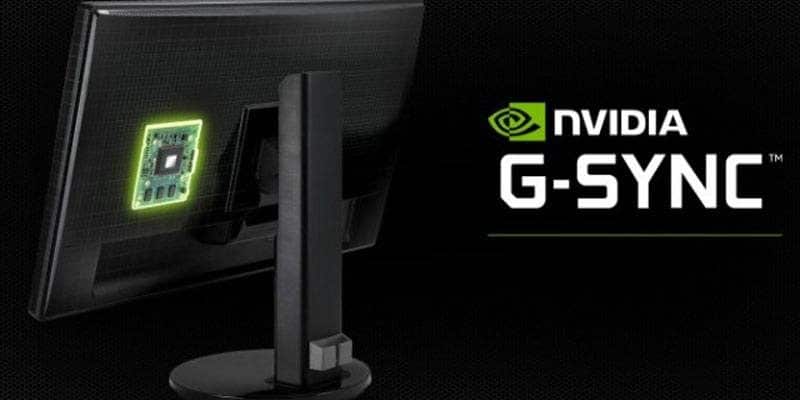
In today’s market of adaptive-sync displays and wide support for Variable Refresh Rates (VRR) from both NVIDIA and AMD systems, the application for NVIDIA’s proprietary G-sync module chip has shifted focus. Yes, you still get the benefits of consistent and stable VRR performance, including a very wide VRR operational range. That often gives more reliable performance than adaptive-sync screens, especially those which lack certifications under AMD’s or NVIDIA’s testing schemes. Although there are still VRR-specific benefits and uses for the module, importantly it can also offer several other key benefits including Variable Overdrive (definitely not to be overlooked), super-low input lag and specifically relevant for this announcement, advanced support for blur reduction modes with unique ‘vertical dependent overdrive’. We will discuss this in more detail later.
ULMB 2 – Improvements, Benefits and Requirements
ULMB 2 is the new scheme being launched today and marks NVIDIA’s first major update to this blur reduction technology. The original implementation of ULMB from their G-sync module (ULMB 1 as it is now) really only required that it could strobe the backlight and offer a blur reduction mode. The level of performance or it’s capability was not really considered. Now, NVIDIA are taking it a step further and setting a series of measures and requirements for an improved ULMB 2 performance.
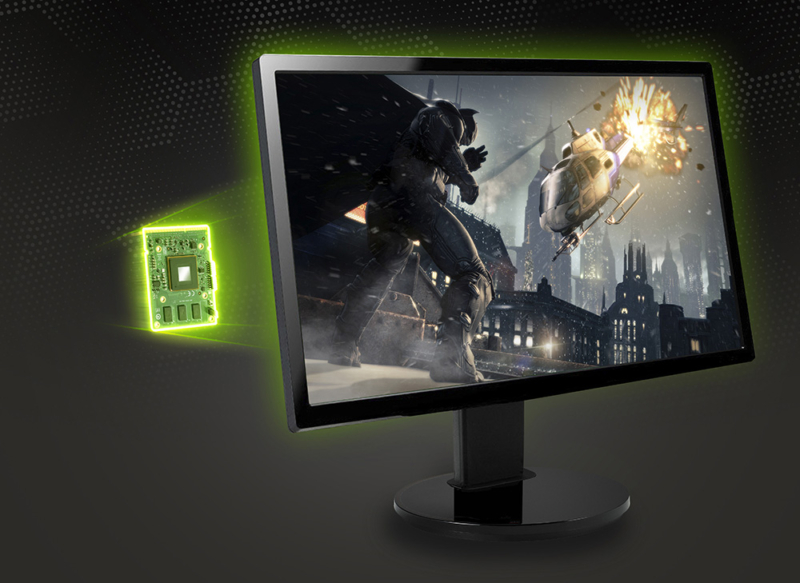
They will also be introducing a certification scheme so that displays that can meet their requirements can earn the “ULMB 2” badge, and display it on the monitor product page and packaging. If a screen promotes ULMB 2 it should meet their criteria, if it simply lists ULMB (or another blur reduction mode) it is only really an indication that it includes some kind of blur reduction mode, which may or may not be any good. It’s nice to see the first steps towards setting some requirements for blur reduction modes here with this new scheme. Perhaps a third party scheme should be introduced to certify performance of blur reduction for non-G-sync module screens too?
Anyway, the requirements for ULMB 2 are as follows:
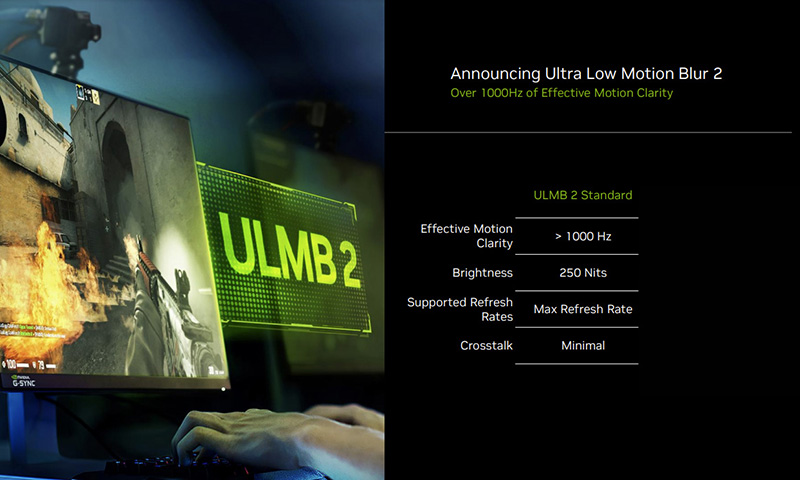
Importantly you can see that blur reduction must now be available at the maximum refresh rate of the monitor, and that the brightness must be able to reach at least 250 nits. Strobe crosstalk is harder to quantify and is only defined as “minimal” here, although the ability to create custom overdrive timings from the G-sync module for ULMB mode, and the unique ‘vertical dependent overdrive’ help reduce ghosting during operation, and (according to NVIDIA at least) creates a larger region of clear image on the screen. More on overdrive control and improvements a bit later.
We are in the process of sourcing a sample of one of the compatible ULMB 2 screens discussed later to test and review so we can consider the performance and benefits in more detail.
Effective Motion Clarity Explained
You will notice as well that NVIDIA have set an “effective motion clarity” target for ULMB 2 certification, listed here at “>1000Hz”. By this they mean that with blur reduction mode enabled on the display, it should offer the equivalent motion clarity for the user of a (hypothetical) display with at least 1000Hz operating when operating without any blur reduction mode.
Perceived motion clarity of a display improves as refresh rate increases, provided the panel response times can effectively keep up. There are major benefits for instance when moving from a 60Hz to a 120Hz/144Hz display because of this, offering far clearer and smoother motion. These benefits increase as refresh rate goes up, although to a lesser extent. There still decent benefits when moving from 120Hz to 240Hz, but smaller benefits when moving from 240Hz to 360Hz and so on. Still, the performance of any screen that wants to be certified under the ULMB 2 scheme should be equivalent to a >1000Hz motion clarity.

To calculate this NVIDIA ran a series of tests using a customer-built pursuit camera setup which is designed to capture and measure accurately real-world perceived motion clarity – something even Mark at Blurbusters would be envious of we’re sure! They were then able to compare a 480Hz capable panel (running with no blur reduction) alongside a 120Hz + ULMB panel.

Comparing the pursuit camera results from both showed that the motion clarity of the slower display when using ULMB was very similar, if not actually even a bit better, than the native 480Hz panel. Ignore the brightness variation here, what we’re comparing is the blurriness of the image. So the basic assumption here then is that because ULMB is using a 25% duty cycle (the ‘on’ period of the strobe is a quarter of each frame), a screen with decent ULMB operation has the “effective motion clarity” equal to four times (4x) its actual refresh rate. So 120Hz x 4 = 480Hz effective motion clarity.
With the ULMB 2 certification stipulating >1000Hz effective motion clarity, that means the screen needs at least a 250Hz refresh rate with G-sync and ULMB operation to have a chance. This therefore excludes 240Hz refresh rate monitors, which would only reach 960Hz max by this calculation, and means the scheme will really only apply to 360Hz+ models. This ULMB 2 scheme and capability is really for the top end of the G-sync gaming monitor market.
ULMB runs at fixed refresh rates only
We should note that ULMB still cannot be used at the same time as VRR which is a shame, with NVIDIA explaining to us that this is very difficult to get working properly and to their high performance standards. With tearing being generally less of a concern at high refresh rates, running ULMB at a fixed 360Hz (or higher) refresh rate is likely to be fine for most gamers they say. Hopefully NVIDIA will be able to add VRR support at a future date as it’s something we’d like to see offered for a more complete gaming experience.
Two Existing 27″ 1440p 360Hz Monitors Can Benefit from a Firmware Update Now!
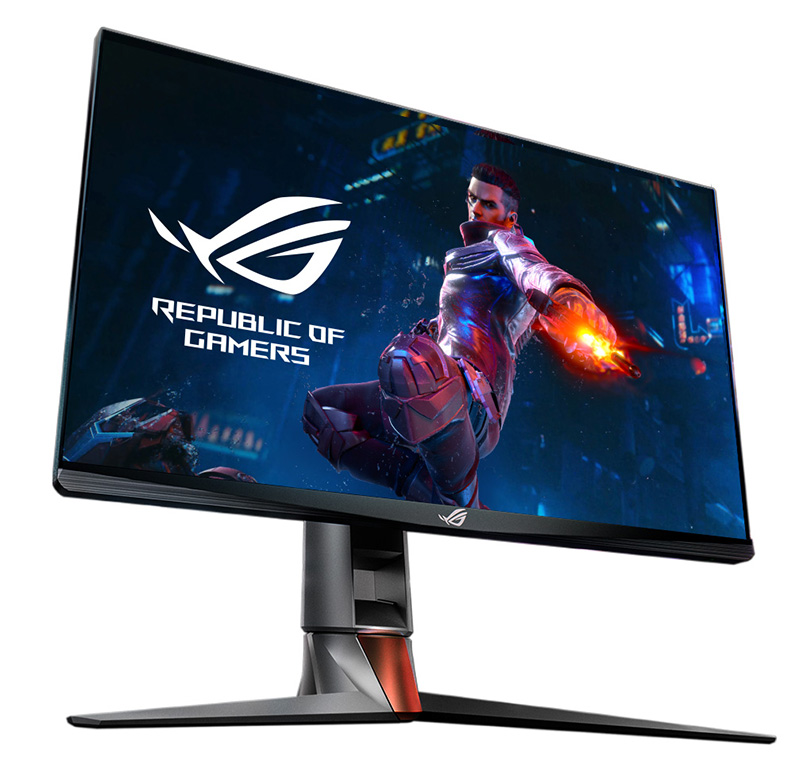
This isn’t exclusively a technology for future unreleased monitors, it will also be available on two existing models that don’t have any form of blur reduction mode at the moment! Those are the Asus ROG Swift PG27AQN we have recently reviewed (check pricing and buy on Amazon here, and in the UK from Overclockers here) and the Acer Predator XB273U F (check pricing and buy on Amazon here) . These are the first two 27″ sized monitors to market that combine a 1440p resolution with a 360Hz refresh rate, and that feature NVIDIA Native G-sync module, a pre-requisite for ULMB 2 to work. They didn’t have any blur reduction mode at all before, so this is a completely free update in capability which is really cool!
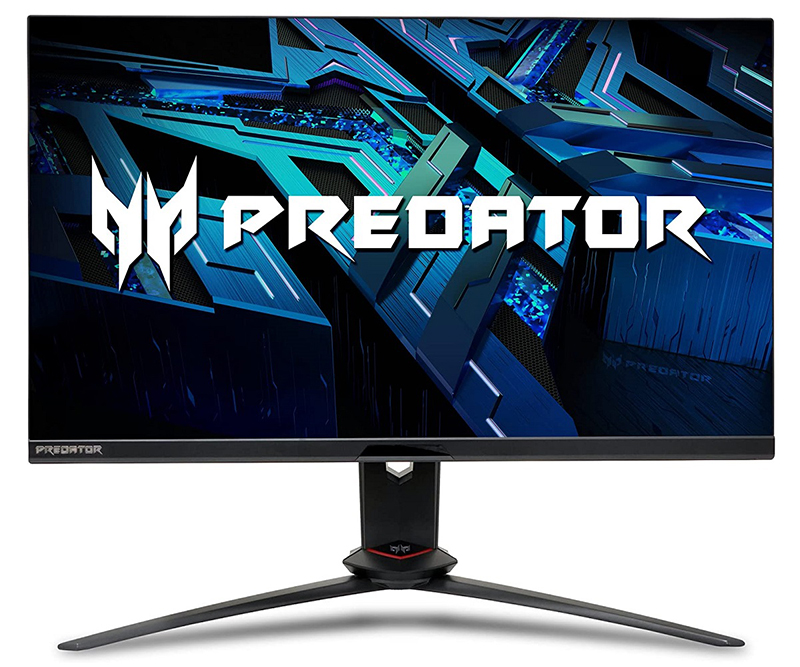
NVIDIA are promoting these screens as “the new Esports standard” as they offer gamers a nice step up in resolution from common 24″ 1080p monitors in this space. They include of course a modern high refresh rate of 360Hz, which is a good start for any gaming display, There is the resolution upgrade from 1080p to 1440p if you want it, for more image detail and clarity. A larger screen size of 27″ to improve immersion and visual area. And NVIDIA-specific gaming technologies like Native G-sync support (with the benefits discussed above) and their Reflex Latency Analyzer tool. For those gamers who still want the 24″ 1080p experience, the monitors also support “Dual format” mode, where you can run 24″ 1080p, with or without scaling, within the 27″ screen size, basically giving you the choice between both options from a single screen. This gives you flexibility for different gaming titles and scenarios.
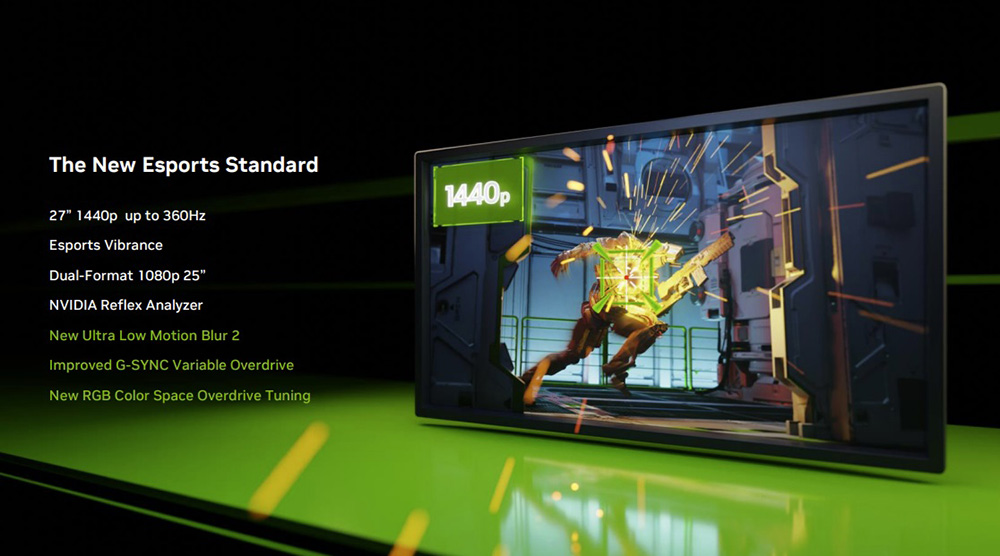
These 2 displays will have a new user-updateable firmware released by Asus/Acer on their support pages, that will quickly and easily update the G-sync module and offer several improvements, allowing them to support ULMB and conform to the requirements as well as offer some improvements in other gaming areas:
- New ULMB 2 certified blur reduction performance
- Improved G-sync Variable Overdrive tuning to improve response times in VRR situations (not available when running ULMB)
- New overdrive tuning in line with NVIDIA’s more stringent testing methods (discussed below), including adjustments for ULMB blur reduction mode and vertical dependent overdrive (also discussed below).
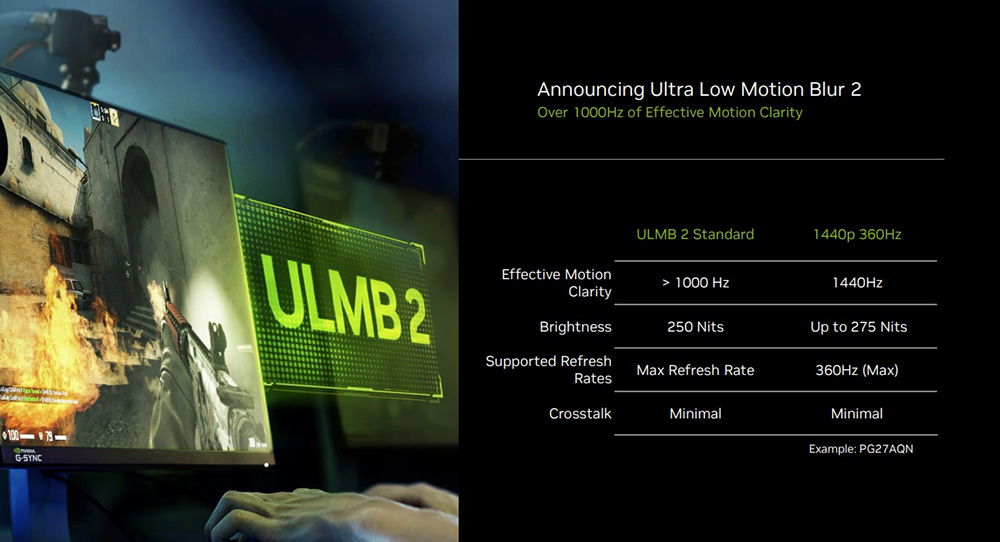
You can see above as an example the way in which the Asus PG27AQN meets the ULMB2 requirements nicely with the update.
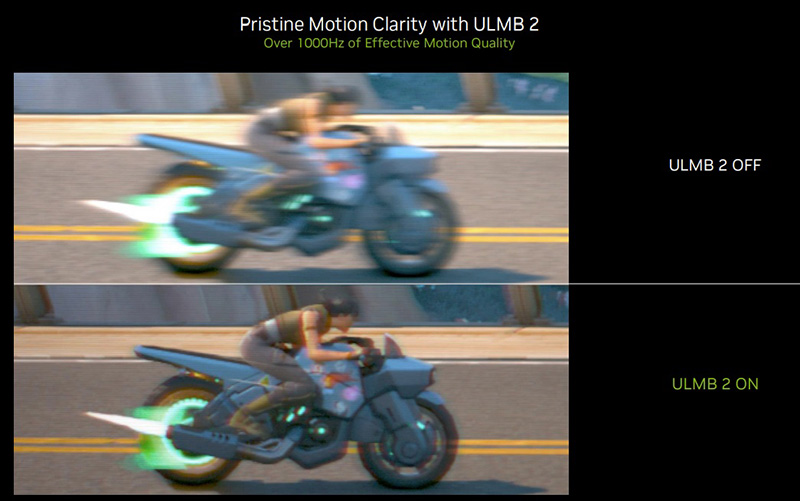

With ULMB 2 enabled there are significant improvements in motion clarity in practice, as shown in the captured photos provided by NVIDIA above, from their custom-built pursuit camera testing software, and from in-game during Valorant.
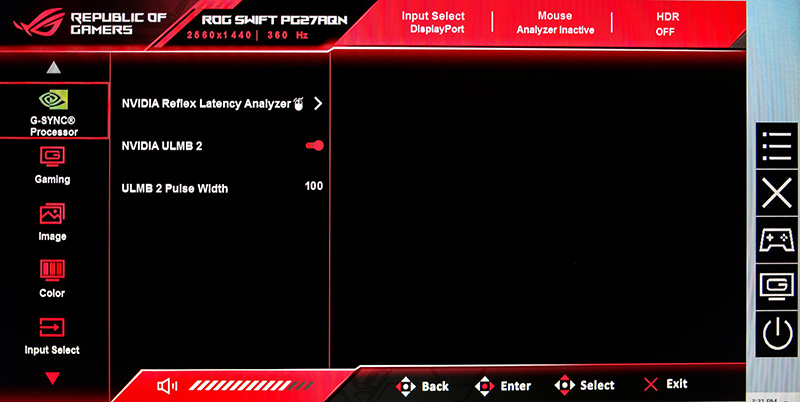
Will other screens receive an update?
Why isn’t ULMB 2 available on more monitors that are available now? It really comes down to two requirements. Firstly the monitor must use NVIDIA’s Native G-sync module, and many high refresh rate gaming monitor manufacturers instead use adaptive-sync for VRR. Secondly it needs to have a refresh rate of 360Hz+ to meet the motion clarity requirements set under the ULMB 2 scheme. 240Hz, which is far more widespread, isn’t quite enough (that would deliver ~960Hz equivalent motion clarity).
There aren’t any others then at the moment that meet the requirements with 360Hz models like the 24.5″ Asus ROG Swift PG259QN not supporting ULMB at the max refresh rate (240Hz limit) and also not reaching the required brightness threshold (225 nits max measured in our testing).
We’ve tested ULMB 2 and the other updates made to the Asus PG27AQN
Update 20 June 2023: We’ve had chance to test ULMB 2 and all the other updates talked about in this article on the Asus ROG Swift PG27AQN. You can find loads more details and our results in our video here. Our full written review of the display is also now available here.
Other Monitors Are Coming with ULMB 2
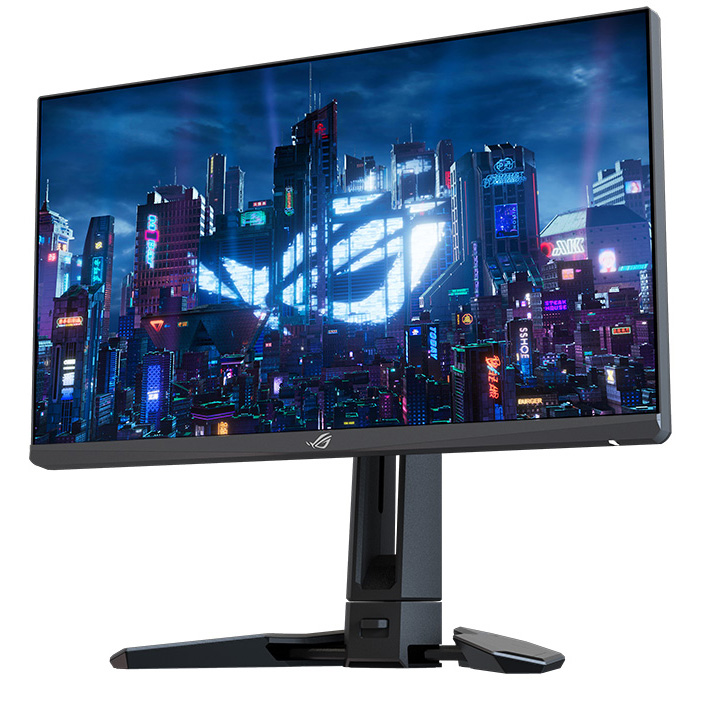
There are of course other monitors that will be released later on that will include ULMB 2 out of the box. Those include the Asus ROG Swift Pro PG248QP (now reviewed, and pictured above) with its 1080p 540Hz panel, and the AOC AGON AG276QSG which is a so far unannounced, but teased at CES 2023 in January by NVIDIA, new 27″ 1440p 360Hz model. More will follow in the future we’re sure.
NVIDIA Have Moved to a Better Overdrive Tuning Approach

Linked to the launch of ULMB 2, NVIDIA also talked to us about improvements they are making to their own testing, which informs response time and overdrive tuning for G-sync monitors. We’d like to think that this is at least in some way encouraged by the work we’ve done on this topic in the last couple of years, as well as that from other outlets on the same topic.
To help improve response times on supported monitors, NVIDIA have now moved to an improved methodology in their lab when it comes to testing response times and overshoot, and then tuning the overdrive performance from there. G-sync module screens include (in simple terms) loads of tables of overdrive timings to account for different fixed and variable refresh rates in a very complex look-up. This is what allows for things like Variable Overdrive to function (discussed below). They also have different overdrive timings for when ULMB blur reduction mode is on and off, allowing further tuning and tweaking for blur reduction mode, as well as vertical dependent overdrive control which we will talk more about in a moment. This is one of the key benefits of baking a blur reduction mode in to the NVIDIA G-sync module, as it allows custom timing for blur reduction operation, all carefully tuned and adjusted in the NVIDIA lab.
In discussions with the NVIDIA product team they explained that they’d moved their testing to a more accurate RGB-based measurements approach, akin to our own “gamma corrected” response time method. This is great news as the measurement of response times and overshoot should now be more closely linked to what you see visually, instead of a linear light-based measurement. The net result is that the overdrive tables used on these G-sync module screens should now be more accurate than ever, ensuring less overshoot and better visual performance.
If you’re interested to read more about why gamma corrected response times are more accurate, and all our studies in to picking an optimal testing approach, you can read our full article here.
Variable Overdrive is a Key Benefit of the G-sync Module

Variable Overdrive is a technology almost exclusively reserved for NVIDIA G-sync module screens. A few manufacturers have attempted to add this separately to adaptive-sync screens, but it rarely offers the same level of performance or sometimes doesn’t seem to work at all. It’s a technology made possible by the G-sync module whereby the overdrive impulse that is driving pixel transitions can be dynamically controlled during Variable Refresh Rate (VRR) situations. As the frame rate reduces, the overdrive is toned down a bit, and it’s increased again as frame rate rises. This is done to help avoid overshoot artefacts and problems as the refresh rate lowers and works very well. G2G response times slow a bit as this happens, but you avoid visual problems and inverse ghosting which is very important. It results in a single overdrive mode experience for the user, something that we consider to be pretty much a baseline requirement for modern gaming screens as we talked about here.
On adaptive-sync screens it is very hard to balance performance in VRR situations. On the one hand if you set overdrive relative to only the maximum refresh rate, you might get the best performance there with decent G2G times and low overshoot, but without Variable overdrive those G2G response times then remain the same in VRR as the refresh rate lowers. This then results in overshoot artefacts increasing as you go, to the point where at the lower end the overshoot is very noticeable and often makes it unusable. You can sometimes get around this by then manually changing the overdrive mode, but this is a pain and lacks a simple “set and forget” option for the user.
The alternative would be to be more conservative with the overdrive application, helping avoid as much overshoot at the lower end, but then perhaps not being fast enough now at the top end of the VRR range. This instead leads to more blurring and smearing. It’s very hard to get right on adaptive-sync screens without Variable Overdrive being available. Variable overdrive avoids these concerns and is a key benefit offered by the G-sync module.
Vertical Dependent Overdrive Explained

We mentioned this earlier but another unique benefit that the G-sync module brings for ULMB operation and performance is vertical dependent overdrive. As NVIDIA explained it to us, because of the timing of the strobe and the way the panel is being refreshed each frame, its possible to configure the overdrive level to be different for different areas of the screen. So in the example shown above you could configure the overdrive to be less aggressive near the top of the screen to help ensure no overshoot, but near the bottom of the screen it could be configured to be more aggressive. Don’t worry about overshoot though, as in this example the strobe/image refresh means that the overshoot portion is “hidden” by the ‘off’ part of the strobe. Without making it more complicated than that basic explanation, which it of course is, this basically means you can fine-tune the response time behaviour across the panel in different ways during ULMB. The result of this is (according to NVIDIA and something we plan to test soon) that you get larger areas of the screen which have a clearer ULMB image with less ghosting and strobe cross-talk. This could be another great benefit of the G-sync module when it comes to blur reduction support.
Wrap Up
NVIDIA also provide a short 5 minute video summarising ULMB 2 and including some demos of their pursuit camera setup which is well worth a watch through.

It’s always good to see investment in improving technologies and bringing more rigor to performance requirements and certifications for monitor performance. The new NVIDIA ‘ULMB 2’ scheme should help bring some reassurance to users in the otherwise pretty murky blur reduction mode market, with some decent criteria defined for what good looks like. The fact that through a series of updates and improvements, two existing displays can benefit from a simple firmware update and improve their performance, while complying with the new ULMB 2 scheme, is obviously great news. It’s an unexpected improvement to a couple of the top end gaming screens on the market today. Update 20 June 2023: We’ve had chance to test ULMB 2 and all the other updates talked about in this article on the Asus ROG Swift PG27AQN. You can find loads more details and our results in our video here, and in our written review here.
- Asus ROG swift PG27AQN – you can check pricing and buy on Amazon here, and in the UK from Overclockers here
- Acer Predator XB273U F – you can check pricing and buy on Amazon here
This also goes to demonstrate that despite it adding some additional cost to monitors, there are still some decent benefits in using the Native G-sync module hardware. Variable overdrive provides a great capability for VRR gaming, along with a usually very reliable high-end and wide range VRR experience. ULMB has always been a capability, but through improvements to NVIDIA’s measurement and overdrive tuning approach with gamma corrected methods now being used; and capabilities like vertical dependent overdrive, this brings some great benefits for blur reduction mode performance and experience. When you build that in to modern high refresh rate screens you’ve got high-end blur reduction mode performance that can now meet the ULMB 2 criteria. Hopefully manufacturers will continue to invest in the G-sync module for their higher-end gaming screens, taking advantage of these benefits and allowing more ULMB 2 certified displays to come to market. There’s already a couple known and planned, but we’d like to see more.
By the way, we did of course take the opportunity to ask NVIDIA about any plans to develop a new G-sync module that could support more modern interfaces like HDMI 2.1, DisplayPort 2.1 and USB type-C and while they didn’t have any official news they could announce or share, they did say this was something that they were certainly looking at for the longer-term future of the technology.
We may earn a commission if you purchase from our affiliate links in this article- TFTCentral is a participant in the Amazon Services LLC Associates Programme, an affiliate advertising programme designed to provide a means for sites to earn advertising fees by advertising and linking to Amazon.com, Amazon.co.uk, Amazon.de, Amazon.ca and other Amazon stores worldwide. We also participate in a similar scheme for Overclockers.co.uk, Newegg, Bestbuy , B&H and some manufacturers.
Stay Up To Date
 |  |  |  |
| Browser Alerts | Follow on X | Subscribe on YouTube | Support Us |
Popular Trending Articles
![[Round-up] All the Latest Awesome 2026 Monitors from MSI at CES 2026 msi ces 2026 website featured](https://tftcentral.co.uk/wp-content/uploads/2026/01/msi-ces-2026-website-featured-130x90.jpg) [Round-up] All the Latest Awesome 2026 Monitors from MSI at CES 2026 January 8, 2026 All our coverage from CES 2026 for MSI’s exciting new 2026 monitors, including new 34″ QD-OLED, 5K dual-mode, Mini LED and G-sync Pulsar
[Round-up] All the Latest Awesome 2026 Monitors from MSI at CES 2026 January 8, 2026 All our coverage from CES 2026 for MSI’s exciting new 2026 monitors, including new 34″ QD-OLED, 5K dual-mode, Mini LED and G-sync Pulsar![[Round-up] Asus Unveil Next Gen Monitors at CES 2026 Asus CES 2026 banner 800px](https://tftcentral.co.uk/wp-content/uploads/2026/01/Asus-CES-2026-banner-800px-130x90.jpg) [Round-up] Asus Unveil Next Gen Monitors at CES 2026 January 9, 2026 All our coverage from CES 2026 for Asus’ exciting new 2026 monitors, including next gen WOLED and QD-OLED monitors, 5K dual-mode and G-sync Pulsar
[Round-up] Asus Unveil Next Gen Monitors at CES 2026 January 9, 2026 All our coverage from CES 2026 for Asus’ exciting new 2026 monitors, including next gen WOLED and QD-OLED monitors, 5K dual-mode and G-sync Pulsar 4th Gen Primary RGB Tandem OLED Monitors Are Here! – Gigabyte MO27Q28G Showcase August 22, 2025 Explaining 4th Gen Primary RGB Tandem WOLED and it’s benefits and specs. Including a showcase of the Gigabyte MO27Q28G monitor
4th Gen Primary RGB Tandem OLED Monitors Are Here! – Gigabyte MO27Q28G Showcase August 22, 2025 Explaining 4th Gen Primary RGB Tandem WOLED and it’s benefits and specs. Including a showcase of the Gigabyte MO27Q28G monitor Here’s Why You Should Only Enable HDR Mode on Your PC When You Are Viewing HDR Content May 31, 2023 Looking at a common area of confusion and the problems with SDR, desktop and normal content when running in HDR mode all the time
Here’s Why You Should Only Enable HDR Mode on Your PC When You Are Viewing HDR Content May 31, 2023 Looking at a common area of confusion and the problems with SDR, desktop and normal content when running in HDR mode all the time![[Update 2] Testing 'HDR400 True Black' and 'Peak 1000' Mode Brightness on New OLED Monitors banner3](https://tftcentral.co.uk/wp-content/uploads/2024/03/banner3-130x90.jpg) [Update 2] Testing ‘HDR400 True Black’ and ‘Peak 1000’ Mode Brightness on New OLED Monitors April 27, 2024 Testing the common HDR modes on new OLED monitors to figure out which mode is brighter for HDR and for SDR content
[Update 2] Testing ‘HDR400 True Black’ and ‘Peak 1000’ Mode Brightness on New OLED Monitors April 27, 2024 Testing the common HDR modes on new OLED monitors to figure out which mode is brighter for HDR and for SDR content
